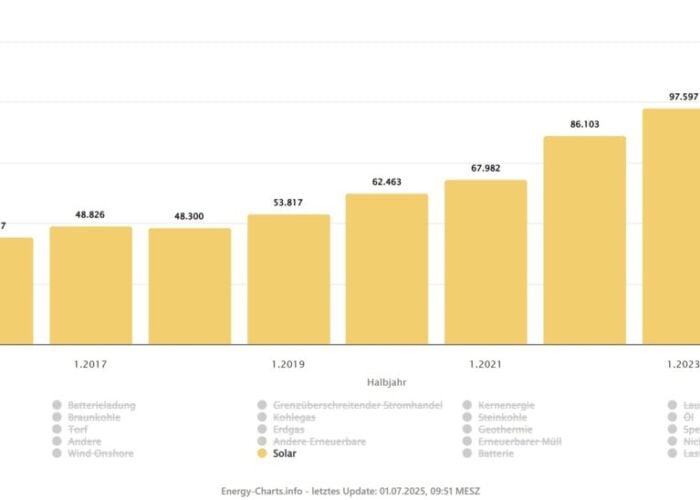
The Brexit referendum and US president Donald Trump’s rise to power aside, 2016 may come to be remembered by future history books as the year of another, highly symbolic political upset.
If Istanbul is the millennia-old link between Europe and Asia, the metaphor was put to the test in July four years ago, as soldiers marched along the city’s very bridges in a bid to depose Turkish president Recep Tayyip Erdoğan. The military coup, spanning the 15 million-inhabitant metropolis and other major cities, failed and was followed by a crackdown by Erdoğan that saw thousands arrested within weeks. The chaos spilled into the macro-economic front, sending the Turkish lira into a short-term downwards spiral and fuelling a 1.3% nationwide GDP drop in Q3 2016.
Unlock unlimited access for 12 whole months of distinctive global analysis
Photovoltaics International is now included.
- Regular insight and analysis of the industry’s biggest developments
- In-depth interviews with the industry’s leading figures
- Unlimited digital access to the PV Tech Power journal catalogue
- Unlimited digital access to the Photovoltaics International journal catalogue
- Access to more than 1,000 technical papers
- Discounts on Solar Media’s portfolio of events, in-person and virtual
Few markets of those examined by PV Tech Power have known such upheaval in recent years and yet Turkish solar appears to have come out unscathed. Historic IRENA stats chart (see Table 1) a surge in installed PV capacity even as Turkey reeled under the coup in 2016 (833MW) and staggered ahead to 2017 (3.4GW) and 2018 (5.06GW). Fast forward to late 2019, and cumulative capacity was said by state grid operator TEIAS to approach 6GW, after 923MW were rolled out over the year. Approached for this story, operators claim annual additions of 1GW are possible going forward.
According to the Institute for Energy Economics & Financial Analysis (IEEFA), Turkey has every incentive to make sure PV growth comes as quickly as the industry wants. The country, the think tank wrote in a recent paper, faces the risk of a “ballooning” energy trade deficit as it continues to rely on its temperamental currency to fund fossil fuel purchases abroad. The state, IEEFA analysts noted, spent 12% more on coal imports in 2018 – reaching US$4.4 billion that year – but a depreciating lira means it may not be able to buy enough to sustain its pipeline of new coal.
Turkey, the IEEFA suggested, could curb the coal dependency by seizing on its PV resource of 1.6MWh/kWp, “some of the best” worldwide. To illustrate the untapped nature of Turkish PV, the think tank drew comparisons with Germany; the Northern European state is half the size, features lower irradiation levels – 1.1MWh/kWp – but has installed 50GW where Turkey can only claim 6GW. Urging Ankara to play catch-up, IEEFA remarked: “The beauty of solar power for Turkey is that it exploits one of its most valuable energy assets, where it has a natural advantage.”
| 2015 (1) | 2016 (1) | 2017 (1) | 2018 (1) | 2019 (2) | 2020 (3) |
|---|---|---|---|---|---|
| 249MW | 833MW | 3.4GW | 5.06GW | 6GW | 6.8 – 7GW |
Table 1. The past and future of Turkey’s solar ambitions – cumulative installed capacity over the years. Sources: [1] historical figures until 2019, International Renewable Energy Agency (IRENA); [2] cumulative volumes by late 2019, TEIAS; [3] forecast for 2020, GÜNDER
The long game of large-scale YEKA growth
Post-coup attempt Turkey may have a sound reason to embrace a multi-gigawatt shift to solar, but does it have a sound plan?
Eren Engur, board member of Turkish solar body GÜNDER, is decidedly upbeat when PV Tech Power puts the question to him. “I see 2020 as the start of a sustainable solar market of 1GW per annum,” says Engur, who heads up GÜNDER’s Energy Storage Committee and is also the founder and CEO of consultancy Icarus Energy. “With the upcoming new YEKA schemes [of large-scale tenders], rooftop support, hybrid regulations along with energy storage and e-mobility support regulations, Turkey can even exceed the expectations.”
Engur predicts the distributed PV segment will dominate in the shorter term, helped along by new net metering incentives. GÜNDER, he notes, believes most of the 800-1,000MW of Turkish solar additions it expects in 2020 will be self-consumption rooftops. Fast forward to 2021, though, and the spotlight may move to large-scale PV growth under the YEKA programme, Engur adds. He points at the upcoming 1GW YEKA solar tender due this spring, which he says will help bolster large-scale PV installations in 2021 and beyond.
Launched in 2016, the so-called YEKA scheme already awarded in 2017 15-year feed-in tariffs (FiT) to a Hanwha Q Cells-Kalyon Enerji consortium, who reaped a winner-takes-all 1GW solar contract. After a further 1GW round was cancelled in January 2019, Ankara’s fresh attempt this year is reported to involve a shift from one to various winners, with contracts divvied up into 100 lots of 10MW capacity each. Noting Turkey’s move away from FiT support, Engur comments: “For the upcoming solar era we’ll be witnessing reverse auctions for GW tenders based on US dollar or euro.”
With caveats, the bright outlook is echoed by Levent Yıldız, general manager of solar developer YP Enerji. The Ankara-based firm – with rooftop arrays and 1-10MW ground-mounted projects under its belt – has witnessed the solar growth fluctuations of the past years in Turkey, from the steady roll-out before 2017 to the boom and contraction sequence that followed. Yıldız notes, however, that the country more or less achieved its optimistic PV installation goals and offers today, despite the recent volatility, a “consistently” reliable economic and legislative framework for investors.
This is an extract of an article first published in Volume 22 of PV Tech Power. The full article can be read here, or in the full digital copy of PV Tech Power 22, which can be downloaded for free here.







